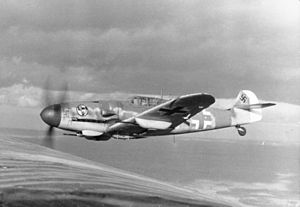 The update is now live!---== UPDATE FL2060: ADLERTAG ==---
The update is now live!---== UPDATE FL2060: ADLERTAG ==---By: Robert & Grumpy
All made possible by: Bcamel (creator of the program used to model the airplanes), and Idunno (who has shared a vast amount of aerodynamical knowledge)
--= Bf 109 series =--After months of remodeling and getting this series as close to historical performance as possible, we are happy to finally announce the full rehaul of the whole Messerchmitt Bf 109 series. See further down for details.
--= Yakovlevs =--Slight roll rate improvement for the Yak-9D, Yak-3 and Yak-9U.
--= Lavochkins =--Slight wing efficiency reduction fix due to data found that leading edge slats increases induced drag when extended. This fix affects all the La5's and La7's.
--= Focke Wulfs =--The Fw 190A-8, F-8 and D-9 have had their Bst2 renamed from "MW50 injection" to "MW50 injektion" with correct German spelling.
--= Macchis =--The C.202's and C.205 have had minor fixes in dragco and engine setup from better data found while remodeling the Bf 109 series.
--== THE BF 109 MESSERSCHMITT SERIES FULL REHAUL ==--There were no other aces in ww2 with as many kills as the German Bf 109 pilots. The Messerschmitts were used at all fronts by the Germans and even scored a very impressive tally in Finnish hands against the Russians. There has been a lot of propaganda after the war where Allied countries claimed their fighters were far superior to their German adversaries, but make no mistake, the Bf 109 is a very potent fighter that has several outstanding traits, while also having some apparent drawbacks. The Messerschmitt is a small lightweight fighter and can definitely give a Spitfire a good run for the money in a slow speed turnfight and is very maneuverable below 300 mph. Especially the F's and K's hold a great sustained turn rate due to their high power/weight ratio, but even E's and G's are quite decent. The small wing area is fairly well counteracted by the leading edge slats, allowing this fighter a high max AoA and surprisingly low stall speed for it's wingloading. While the normal Bf 109's are a bit lightly armed, the G-6/RVI and K-4/RIV versions pack a heavy punch with their added gondola cannons in exchange for a decrease in speed, climb-, turn- and roll rate. The Messerscmitts have a major Akilles heel in that their elevator, rudder and aileron controls quickly become heavier with increasing airspeed. As such a Bf 109 can turn with a Spitfire below 250 mph IAS but is fairly equal to a P-51D above 300 mph IAS, and above 400 mph IAS a P-51D can easily get on the Bf 109's six. There are several accounts of German Bf 109 pilots crashing when trying to follow a British fighter in a low altitude dive due to inability of pulling out of the dive, and a known tactic used by British pilots was to roll over, dive and then pull out in order to evade a Bf 109 on their six. A Bf 109 pilot in Warbirds will do well to be ready with the elevator trim to get out of a dive or to tighten the turn in high speed dogfights. Heavier fighters will do well to keep their speed high when fighting a 'Schmitt. A Warbirds player probably needs a bit of a learning curve to get skilled in this German fighter, but the Messerschmitts are definitiely very competitive fighters that have the ability to bring down any opposition, especially with an Experten in the cockpit who knows how to manage his Bf 109's strengths and weaknesses.
--= Bf 109E-1 =--The E-1 is lightly armed with 4x 7.92 mm MG's and has a max output of 1134 hp at 4100 ft with it's DB 601 engine. The 1.40 ata boost can be used for 1 min stints with a 2 min cooldown, while 1.30 ata can be used for 5 minutes.
--= Bf 109E-3 =--The E-3 has an improved DB 601 engine with a better high altitude performance, and replaces the wing 7.92 mm MG's with 20 mm MG/FF cannons.
--= Bf 109E-4 =--This version is very similar to the Bf 109E-3, but has slightly better MG/FF/M cannons instead of the MG/FF cannons of the E-3.
--= Bf 109E-4 Aa =--The best known Bf 109E version, the E-4 Aa has the DB 601Aa engine which can produce 1212 hp at 4000 ft for 1 minute stints. There are several 1939-1940 era fighters that can turn tighter than the 109E's, but the 'Schmitts can usually outrun these opponents. Still, if on the six of a Spitfire, the Bf 109E's can keep inside it's turn for several laps. The Hurricane outturns the Bf 109E's though.
--= Bf 109F-1 =--The F's might be the pinnacle of the Messerchmitt series and sees the wing cannons removed for a single nose cannon. The Bf 109F's and future 109's have redesigned wings with a better wing efficiency and lower drag than the E's, and can also bring a droptank. The F-1 benefits from a good power/weight ratio with the DB 601N engine capable of producing 1243 hp at 6900 ft for 5 minute stints.
--= Bf 109F-2 =--Very similar to the F-1, but with the 20 mm cannon replaced with a 15 mm MG/151/15 cannon and 200 rounds instead of 60 rounds.
--= Bf 109F-4 =--The best F version equipped with the even further improved DB 601E engine. It also has a 20 mm MG/151/20 cannon with 200 rounds instead of the 15 mm cannon of the F-2. The F-4 has great top speed for it's time and can turn with most 1941 era fighters at low speeds.
--= Bf 109G-2 =--The G-2 fields the DB 605A-1 engine which has a better high alt performance than the DB 601 engine. Problems with engine reliability resulted in the G-2 being restricted to 1.30 ata though. As such it's has a better top speed above 20000 ft than the F-4, but is generally a bit more cumbersome at lower alts than the F's.
--= Bf 109G-6 =--The G-6 has the DB 605A-1 engine like the G-2, but is cleared for use of 1.42 ata with a max output of 1529 hp at 6800 ft at 1 minute stints. It has improved armament with 2x 13 mm MG's replacing the 7.92 MG's and packs a better punch. It's a bit heavier than the F's though and slightly worse in turn fight at low alts, but is a good high alt performer.
--= Bf 109G-6/RVI =--This is a G-6 with added gondola cannons in the wings, packing a heavy punch and a is great tool against bombers. This added firepower comes at the expense of a ~5 mph slower top speed and decreased climb-, turn- and roll rate due to the added 474 lb weight of the wing cannons.
--= Bf 109G-14 ASM =--An improvement to the G-series, the G-14 ASM has an engine tooled for high alt performance, and more importantly can use the MW50 methanol/water injection. This allows a markedly increase in max power output and it can keep it's WEP for 10 minutes before the engine starts to overheat (total MW50 capacity is 20 minutes). This Bf 109 version is a serious threat to any opposing fighter of it's era.
--= Bf 109K-4 =--This is the ultimate version of the Bf 109 series. An added feature is the choice of using the heavy 30 mm MK/108 cannon instead of the standard 20 mm cannon. The DB 605DC engine can produce 1988 hp at 1400 ft with MW50 injection and C3 fuel, which gives the K-4 a power/weight ratio even greater than the Spitfire XIV, and can definitely match the Spit XIV in a sustained low n' slow turn fight. The top speed matches any late war fighter below 20000 ft and if the German pilots of ww2 hadn't been constantly outnumbered 1v5 or even 1v10 in the era of the K-4, this version would probably have made a much better tally for itself. The Akilles heel of the Messerchmitts is the heavy high speed handling though, and in the 1944-1945 era where speeds are much higher than in the earlier years of ww2, this is an even more significant drawback for the K-4 pilot that often will need to try to lure the often heavier enemy fighters into a slow speed dogfight.
--= Bf 109K-4/RIV =--Like the G-6/RVI, The K-4/RIV has added firepower from it's gondola wing cannons at the expense of top speed and agility.
SUSTAINED TURN RATE AT SEA LEVEL, NO FLAPS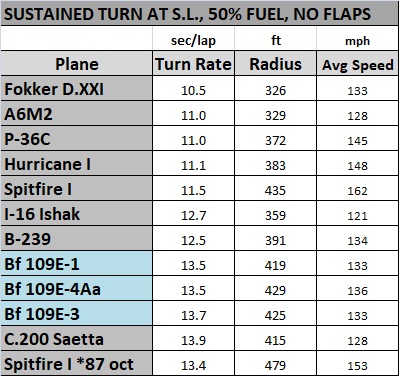
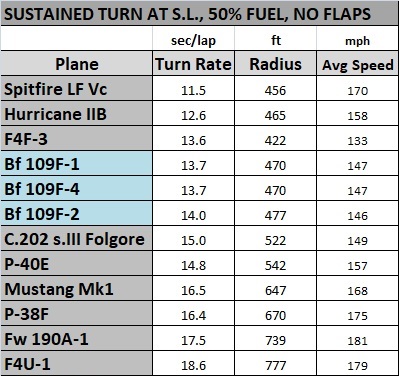
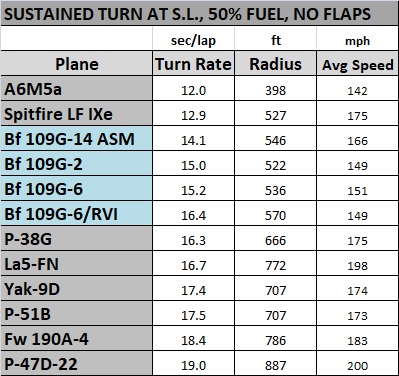
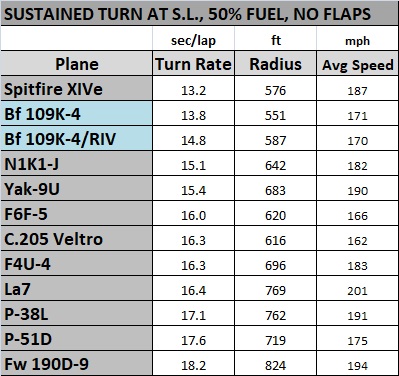 TOP SPEEDS
TOP SPEEDS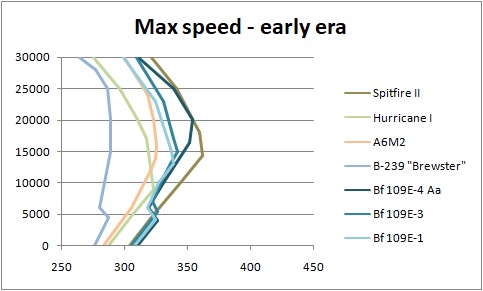
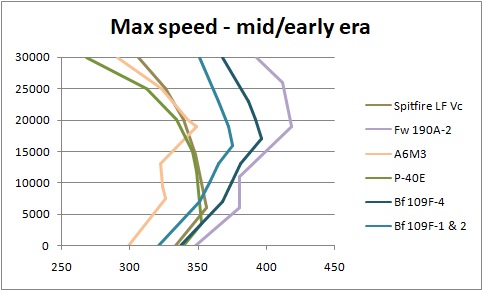
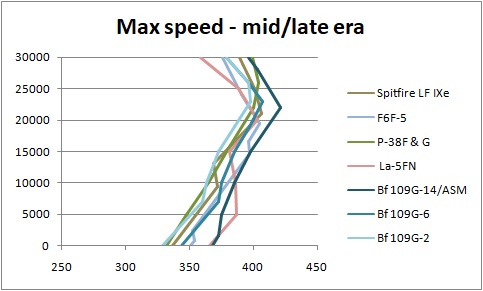
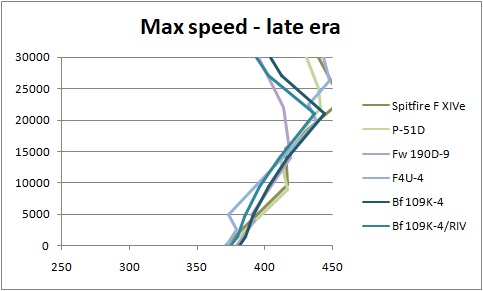
<S>!
/Robert






